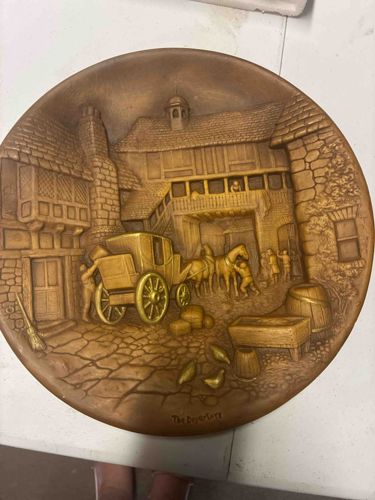
The Dyer's Inn 3D Relief Decorative Plate
This item is a circular, relief-sculpted decorative plate or wall plaque, likely made from a composite material such as resin, plaster, or a ceramic blend, designed to mimic the appearance of a carved wooden or fired clay piece. Its color palette is entirely within shades of brown and gold, with the main body presenting a matte, earthy brown, and select raised elements, such as carriage wheels and elements of the building, highlighted with a metallic gold finish to emphasize detail and add visual interest. The construction features deep three-dimensional relief, creating significant depth and shadow play across its surface. The scene depicted is a bustling, old-world European street or courtyard, possibly at an inn or livery stable. Key elements include a horse-drawn carriage or coach with intricately designed wheels and body work, several human figures interacting with the horses and carriage, and a detailed architectural backdrop of multi-story buildings with visible timber framing, brickwork, and tiled roofs. One building prominently features an upper-level balcony or gallery. The ground surface is textured to represent cobblestones or uneven paving, with visible cracks and irregularities that enhance the aged aesthetic. Other small details include a broom leaning against a wall, barrels, troughs, and what appear to be chickens or small birds on the ground. The overall condition appears good with a deliberate aged patina applied through its coloring; no obvious chips, cracks, or significant wear are immediately apparent from the image. The relief work is of good quality, showing fine detaiing in the figures, architecture, and horse harnesses. A notable inscription 'The Dyer's Inn' is faintly visible along the bottom edge, suggesting the specific location or name of the scene depicted. Given the style and common manufacturing techniques for such decorative items, it likely dates from the mid-to-late 20th century.
AI-Generated Appraisal Disclaimer
Estimated Value
$30-60
Basic Information
Category
Decorative Plate/Wall Plaque
Appraised On
November 28, 2025
Estimated Value
$30-60
Item Description
This item is a circular, relief-sculpted decorative plate or wall plaque, likely made from a composite material such as resin, plaster, or a ceramic blend, designed to mimic the appearance of a carved wooden or fired clay piece. Its color palette is entirely within shades of brown and gold, with the main body presenting a matte, earthy brown, and select raised elements, such as carriage wheels and elements of the building, highlighted with a metallic gold finish to emphasize detail and add visual interest. The construction features deep three-dimensional relief, creating significant depth and shadow play across its surface. The scene depicted is a bustling, old-world European street or courtyard, possibly at an inn or livery stable. Key elements include a horse-drawn carriage or coach with intricately designed wheels and body work, several human figures interacting with the horses and carriage, and a detailed architectural backdrop of multi-story buildings with visible timber framing, brickwork, and tiled roofs. One building prominently features an upper-level balcony or gallery. The ground surface is textured to represent cobblestones or uneven paving, with visible cracks and irregularities that enhance the aged aesthetic. Other small details include a broom leaning against a wall, barrels, troughs, and what appear to be chickens or small birds on the ground. The overall condition appears good with a deliberate aged patina applied through its coloring; no obvious chips, cracks, or significant wear are immediately apparent from the image. The relief work is of good quality, showing fine detaiing in the figures, architecture, and horse harnesses. A notable inscription 'The Dyer's Inn' is faintly visible along the bottom edge, suggesting the specific location or name of the scene depicted. Given the style and common manufacturing techniques for such decorative items, it likely dates from the mid-to-late 20th century.
Related Tags
Get Your Items Appraised
Instant estimates of your treasures with AI-powered instant appraisals